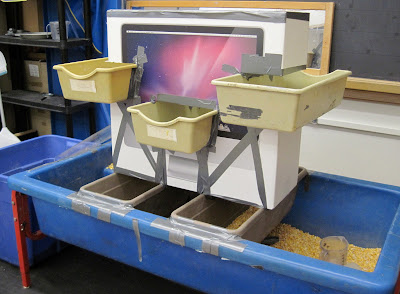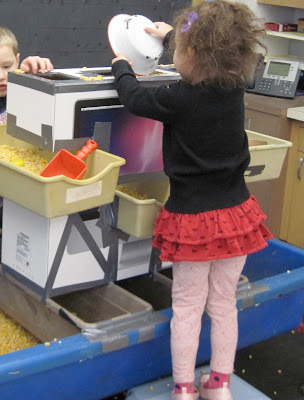I do not always plan out what I am going to build before I actually start building. I often have a general idea, but only when I start the process of building, does it take shape. Right after I constructed the Multiple Trays apparatus, I decided to use the trays again, but this time to embed them in a box. I got a big box and started to physically play with different arrangements of trays to embed in the box. Only after I had decided on the arrangement did I start to cut and duct tape. The result was the apparatus below: Trays in a Box.
For this apparatus, one tray is completely embedded in the box and two of the trays are only halfway embedded. The whole box structure rests on two planter trays that hold it above the table. They also serve as a good anchor on which to duct tape the box. I cut holes in the bottom of the box over the planters so if corn fell in the bottom of the box, it would end up in the planter---not stuck in the bottom of the box.
On the opposite side, I added a clear plastic tube. It fit nicely between the trays to give it a lot of stability. The tube emptied into a tub at the end of the table.
I cut holes on the top of the box over each tray so when the children poured the corn through one of the top holes, it would land in a tray.
Some of the children figured out that they could pour corn into the top and have it end up in the planter trays three levels down. To do that, they would have to aim, but those that figured it out could aim and aim well.
The children found all the levels of the apparatus. And each level created its own challenges.
There is the top level which took stretching or standing and balancing on a stool.
Next, there is the level of the half-embedded trays. To get corn from one of those trays, there is a certain amount of stretching and contorting required.
Next, there is the level of the tray that runs all the way through the box. This space is more closed so when the children scoop, they do not see all their actions. Instead, they have to use their sense of hearing, motion, and resistance to hear and feel if they are scooping the corn.
And there is the bottom of the table. To get corn from the bottom of the table, there is a certain amount of bending and contorting.
Children are even able to create their own levels. In the picture below, a child is using the lips of the planter trays to prop his scoop to form a bridge of sorts that serves as a new level into which to transport the corn.
His solution for balancing the scoop also allowed him to work more freely on yet another level, the level created by the bottom of the planter boxes. Imagine him trying to scoop the corn with one hand all the while balancing another scoop in his other hand. He makes it easier for himself by resting the second scoop on the lip of the trays so he can concentrate on reaching under the box to scoop corn from the tray. That is pretty inventive.
By far the most popular feature of this apparatus was the clear plastic tube. Children found no end to putting the corn down the tube. Some of that was individual and some of that involved taking turns. I say take turns loosely because it often looked like bees buzzing around honey.
Some of the play, though, was more complex and involved coordination of two or more children executing different roles. Inevitably, one child would plug the tube at the end and others would pour corn into the tube to fill it up. The video below shows just such an operation. As you watch it, look at the persistence and patience of all involved to fill up the tube with corn.
Besides the cooperative nature of this play and besides the persistence and patience to see it through to the end, this is really an operation in which the children are experiencing volume on an elemental level. Because the tube was clear, all the children kept the process of filling the tube front and center. That is very evident when the girl blocking the corn makes one last check to see if the tube is indeed full.
Two very interesting things happened with this apparatus with my youngest group. The first was that the tub at the end of the table became a space into which to climb and be one with the corn.
The second thing that happened with the younger group was that the apparatus seemed to encourage climbing.
Silly me, I thought I built a sensory apparatus. The children showed me that it is also a large muscle apparatus. That wasn't the first time this has happened and it won't be the last.











Tom you never cease to amaze me with your sensory tub creations. I wish I had a touch of your passion and skill for creating these apparatuses. Your children are very fortunate.
ReplyDeleteThanks, Maureen. We all have our strengths or our passions. I wish I had your knack for telling stories. One day I will work up the inertia to tell one from your repertoire that I enjoy so much. Tom
DeleteI love the fact you started anyway-not knowing how it might end! A lot of my pupils don't want to commit to something without the safety of knowing what it will become, they are afraid of what might happen...
ReplyDeleteThanks. I have found I need a little inertia to finish a project. I can't get any inertia without starting. Once I start, things start to flow.
Delete